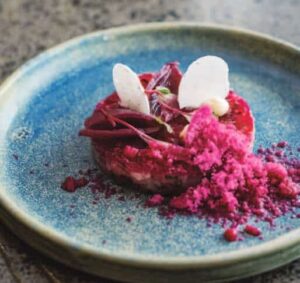the allure of locally-grown produce, abundant seafood and the opportunity to forage for your own has lured some of the country’s finest chefs to the region. James Beck, Jeremy Rameka and David Griffiths have all established restaurants within close proximity of each other.

Asparagus means ‘spring’ as sure as the first cherry blossom flowers. Green and white asparagus are the same variety, with the white picked while the spear is below the ground and the green harvested when the tips are around 20 centimetres above the ground. It takes five years to cultivate good asparagus and the spears are always cut by hand.
To prepare asparagus, thoroughly wash and then break off the woody end of the spear. You can also peel the last 3-4 centimetres to make sure every bit is edible. Steam or boil in salted water for around 3-4 minutes, drain and place on paper towels.
Easy to grow and full of protein, broad beans when combined with fresh mint will create a super fresh taste sensation. Cook in boiling salted water for threem inutes, blanch and then peel off the grey looking shell to reveal the bright green bean. Adding broad beans to a dish is a great way to make your recipes low-GI.

Beetroot as a vegetable is available all year round and when properly prepared can present colour and life to all manner of salads, especially when combined with spring asparagus. Most of us have nasty memories of canned beetroot swimming in vinegar presented on “buffet tables” or maybe at our grandparents’ Sunday lunch table. It can be steamed, boiled, baked or grated and served raw. The leaves are also edible if boiled in salted water for around five minutes.
My favourite way of cooking beetroot is to bake on rock salt for a couple of hours, tightly covered with tin foil in a medium hot oven. Scrub first and then peel once cooked. The flavour is intensified by using this cooking method.
So with the abundance of new seasonal produce shining through, it is a refreshing time for restaurant menu updates and with that in mind I endeavour to find out what is featuring.
The spring menu at Mister D features an asparagus dish, garnished with beetroot, soft goats cheese, freekeh and a sherry vinegar honey reduction. Freekeh is an ancient wheat grain, loaded with nutritional benefits. It is low in fat and high in protein and fiber. It can be used anywhere you would use whole grains, like quinoa, brown rice, farro or bulgur.
Talking to James at Bistronomy (a true forager at heart), he was intrigued to see local cacti yielding a beautiful prickly pear, so he decided to prepare a spring dish venturing on the unusual. This dish (in his mind) was created using the association between cactus and all things

Mexican.
Sourcing the freshest of Hawke’s Bay fish of either trevally, kingfish or gurnard for the tartare, freshly squeezed lime juice, coriander, house pickled red onions, lemon segments and tequila are all combined.
Then the slightly astringent juice of the prickly pear is made into a gel to cover the tartare. To garnish this inventive dish a dusting of smoked ice powder made from the juice of the prickly pear is beautifully sprinkled on to the plate with a baby horopito meringue.
Jeremy at Pacifica has designed a very special dish combining asparagus and whitebait. Whitebaiting is the closest thing New Zealand has to a “peasant” fishery. With the season open until the end of November, whitebaiters are now trying their luck along streams and rivers. Currently selling for around $80 a kilogramme, it is a true delicacy and definitely worth an indulgence before the end of the season.
Three restaurants, three top chefs, three minutes walking distance from each other all achieving ‘hats’ in the 2016 Cuisine NZ Good Food Awards has proved that our Napier ‘hood’ has done extremely well in restaurant terms.

In restaurant jargon ‘hats’ are the equivalent of the Oscars and Hawke’s Bay is a mecca for produce … and so the combination is complete.
Mister D Spring Risotto Recipe
for 4 people
Ingredients: 300g Ferron Carnaroli rice,
600ml vegetable stock,
1/2 onion finely diced,
1 bay leaf,
Olive oil,
4 medium size courgettes,
200g broad beans, blanched and shell removed,
200g Hohepa ricotta,
Bunch of fresh mint,
100g grated parmesan

Method: Using a melon baller cut around 30 balls from the courgettes. Keep aside and grate the remaining off-cuts. Julienne 3 tablespoons of mint, reserving 5-7 per portion of the best sprigs for garnish. Sauté the grated courgette and julienne of mint in olive oil until just tender and set aside. For the risotto, in a heavy-bottom pot swish in a good slug of olive oil and add in diced onion and bay leaf. Cover and cook for around 3-5 minutes until the onions are tender and without colour. In another pot bring the stock to the boil and lightly season. Once the onion is cooked add the rice and toast for 2-3 minutes. Add the hot stock, cover and simmer for 13 minutes. Once the rice is cooked check the consistency and it should be slightly creamy. If not add extra stock. Now add your garnish of grated cooked courgette and parmesan to the rice.Blanch the courgette balls. Drain. Toss the courgette balls and the broad beans with a little olive oil to heat through.
Assembly: Divide the rice over 4 warm plates and scatter the vegetables over the top. Place generous spoons of ricotta around the plate and garnish with mint and more olive oil.

